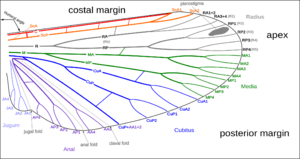Archedictyon facts for kids
Archedictyon (say: Ark-eh-DIK-tee-on) is a special idea about how the wings of the very first flying insects might have looked. It's like a blueprint for the veins in their wings. Scientists believe all winged insects today came from an ancient insect that had this type of wing pattern.
Contents
What is Archedictyon?
The archedictyon is a very old and complex pattern of veins found in the wings of ancient insects. It's like a detailed map of tiny tubes that helped make the wings strong. Scientists use this pattern to help classify and understand these old insects.
This pattern was especially important for studying large, ancient insects called Palaeodictyoptera. These insects lived a very long time ago. A museum database described the archedictyon as:
- The original network of veins in the wings of the oldest insect fossils.
- A complex web of small, uneven veins.
- These veins are found in the outer three-quarters of both wings.
- They also include a part of the wing called the anal lobe.
How is it Structured?
Scientists think the archedictyon had about six to eight main veins running lengthwise. Our understanding of this design comes from looking at fossils. It also comes from what scientists guess based on those fossils.
Two insect experts created a system to describe these veins. It's called the "Comstock-Needham system." Here are the main veins and their branches:
- Costa (C): This is the vein along the very front edge of the wing.
- Subcosta (Sc): This is the second main vein, right behind the costa. It usually does not branch out.
- Radius (R): This is the third main vein. It can have one to five branches that reach the edge of the wing.
- Media (M): This is the fourth main vein. It usually has one to four branches that reach the wing edge.
- Cubitus (Cu): This is the fifth main vein. It can have one to three branches that reach the wing edge.
- Anal veins (A1, A2, A3): These are veins found behind the cubitus. They do not branch out.
There are also smaller veins that connect the main ones. These are called crossveins. They are named by which main veins they connect:
- C-SC crossveins: These run between the costa and the subcosta.
- R crossveins: These run between different branches of the radius vein.
- R-M crossveins: These run between the radius and the media veins.
- M-CU crossveins: These run between the media and the cubitus veins.
Modern Insects with Archedictyon
Even today, some insects have wing patterns that remind scientists of the archedictyon. This means they have kept some very old features. It doesn't mean their wings are simple.
Examples of modern insects with this type of wing pattern include:
- The Mastotermes darwiniensis termite from Australia.
- The Orthodera novaezealandiae praying mantis from New Zealand.
The term archedictyon is also used when talking about phasmids. For phasmids, it means a network of veins in a certain part of their wing. This part is called the costal region or the elytron.
Images for kids
-
Mastotermes darwiniensis or Darwin termite, is an extant species of Australian insect showing archedictyon wing venation.



